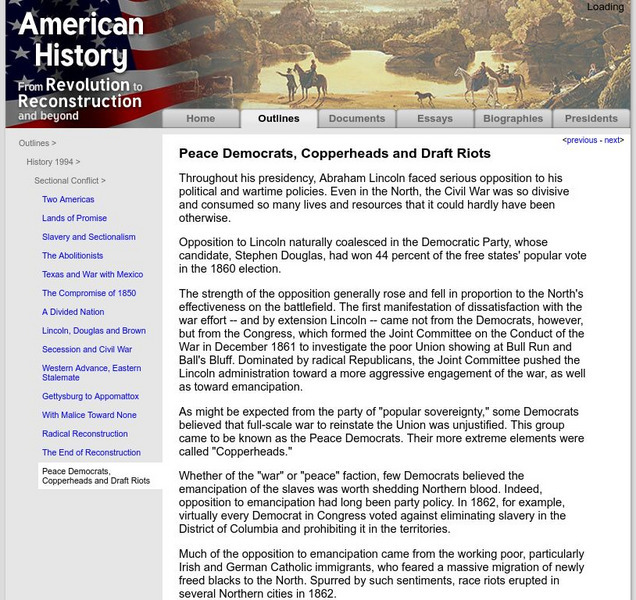Curated OER
Harriet Tubman
Students investigate Harriet Tubman. In this African-American lesson, students read the book A Picture Book of Harriet Tubman and discuss how she was a conductor of the Underground Railroad. Students identify the leadership qualities she...
Curated OER
ESL Holiday Lessons: Abolition of Slavery Day
In this language skills worksheet, students read an article about Abolition of Slavery Day. Students respond to 6 matching questions, 29 fill in the blank questions, 30 multiple choice questions, 12 word scramble questions, 30 short...
Curated OER
Abolition and the Underground Railroad in Essex County
Fifth graders investigate the end of slavery and the hidden paths slaves used to travel. In this U.S. history lesson, 5th graders examine the travel routes slaves used in Essex County known as the Underground Railroad. Students write a...
Curated OER
Do The Research! Abolition of Slavery in America
In this research about slavery activity, students use the Internet or other sources to gather information about the abolition of slavery in America. Students answer 4 short essay questions.
US National Archives
Nara: The d.c. Emancipation Act
Information about, and a scanned copy of page one and five, of the D.C. Emancipation Act which freed slaves in Washington, D.C. in 1862.
University of Oklahoma
Chronology of u.s. Historical Documents: The Emancipation Proclamation 1864
Here you can find the full text of the Emancipation Proclamation, issued by Abraham Lincoln in September 1862, and passed into law on January 1, 1863.
Gilder Lehrman Institute of American History
Gilder Lehrman Institute: History Now: Wilberforce, Lincoln, and the Abolition of Slavery
[Free Registration/Login Required] Tour the online original documents that tell a story about the abolition of slavery in both the United States and England. Click on the tiny "next" above the text to go through the interactive.
Teaching American History
Teaching American History: Manifesto: American Anti Slavery Society
Find the goals of the American Anti-Slavery Society, founded in 1833 by abolitionists in Philadelphia. The object of the group was the immediate abolition of slavery.
A&E Television
History.com: Black History Milestones
A detailed account of the history of African Americans is presented in this article. Divided by main topics or periods of time, the coming of slavery to America is the first focus. Followed by plantation life and escapes to freedom and...
US Government Publishing Office
Ben's Guide to u.s. Government: Emancipation Proclamation 1863
Ben's Guide is a fun way to present U.S. Government to students grades K-12. This site presents a brief overview of the Emancipation Proclamation. Includes the transcript of the document. Links to related sites are available.
Other
19th C. u.s. Women's Writings: Lydia Maria Child's "Slavery's Pleasant Homes"
Text of several of Lydia Child's writings that supported her abolitionist sentiments.
Harp Week
The End of Slavery: The Creation of the 13th Amendment
What a wonderful resource for researching the attempts to solve the issue of slavery prior to the Civil War, and the eventual ratification of the 13th Amendment. Find a timeline of legislation limiting the spread of slavery from 1787...
Cornell University
Cornell University: Library: I Will Be Heard: The 13th Amendment
Read the text of the 13th Amendment, adopted in January, 1865, even before the end of the Civil War, which ended slavery in the United States. Click on the image to see a larger picture of the document itself.
Mariners' Museum and Park
Mariners' Museum: Captive Passage: The Transatlantic Slave Trade
Online exhibition from the Mariners' Museum chronicles the plight of African slaves from the beginning of their journey when they are torn from their homeland all the way to the shores of the Americas. Caught up in the lucrative...
Library of Congress
Loc: Elizabeth Cady Stanton Papers
The papers of suffragist, reformer, and feminist theorist Elizabeth Cady Stanton cover the years 1814 to 1946, with most of the material concentrated between 1840 and 1902. Consisting of approximately 1,000 items, the collection contains...
National Humanities Center
National Humanities Center: Toolbox Library: Sierra Leone, Making of African American Identity: V. 1
An eighteenth-century map, several illustrations by Europeans of Africans from Sierra Leone, and two eighteenth-century narratives depicting Sierra Leone natives through the eyes of two British physicians who describe the peoples they...
University of Groningen
American History: Outlines: Peace Democrats, Copperheads, and Draft Riots
Abraham Lincoln did not have universal backing in the conduct of the Civil War. Read about the opposition, mainly from the Democrats, who opposed emancipation of the slaves and waging a war to reunited the country.
US National Archives
Our Documents: 13th Amendment to the u.s. Constitution: Abolition of Slavery
Take a look at an image of the constitutional amendment that put an end to slavery in the United States. Interactive image is accompanied by an overview of the amendment's inception and adoption, as well as document transcript.
Wikimedia
Wikipedia: Dred Scott v. Sandford
This site from the Encyclopedia Wikipedia provides information on the Dred Scott case, as it progressed through the Missouri state court, the Federal court system, and the appeal that went to the Supreme Court.
British Library
British Library: Abolitionist Campaigners
A collection of short biographies of individuals who were involved in the anti-slave trade movement in England during the late 18th and 19th centuries.
Other
Personal Site: Thomas Clarkson
A nicely done biography of the famous British anti-slavery campaigner in the 18th and 19th centuries.
Other
Personal Site: William Wilberforce
A nice biography of the famous British abolitionist who served in Parliament during the late 18th and early 19th century.
Other
Personal Site: Biography of Anthony Benezet
A short but good biography of the famous Quaker abolitionist who established a school for slaves in Philadelphia in 1770. He wrote a pamphlet in 1772 which led to the establishment of the anti-slave trade movement in England.





















